Original article by @charlotte0211z , Metrics Ventures
1 Jupiter: A leveraged target for the Solana ecosystem
1.1 Will Solana become the “Ethereum Killer”?
Solana is recovering from the FTX crash. After becoming the leader of cryptocurrency gains in the fourth quarter of 2023, Solana continued to ignite market sentiment in 2024 with its ecosystem airdrops and high-multiple increases in MEME tokens, becoming the top candidate for the Ethereum killer. We review the growth of the Solana ecosystem from the perspectives of data, market sentiment, and ecosystem prosperity, and explain why the importance of deploying the Solana ecosystem should be greatly increased in this cycle.
Solanas data is soaring rapidly. Solanas TVL began to grow rapidly in the fourth quarter of 2023, from about $500M on October 1, 2023 to the recent $8B, an increase of 1500% in two quarters, and is approaching the peak of $12B in November 2021; DEX trading volume is increasing rapidly under the influence of MEME tokens. On March 16, the trading volume exceeded $3.8B, a record high. The proportion of DEX trading volume has increased rapidly, approaching Ethereum and even surpassing it for a short time; in terms of token performance, Solanas token price began to rise sharply in October 2023, approaching a peak of $250, and the total market value has surpassed the peak of the last bull market.
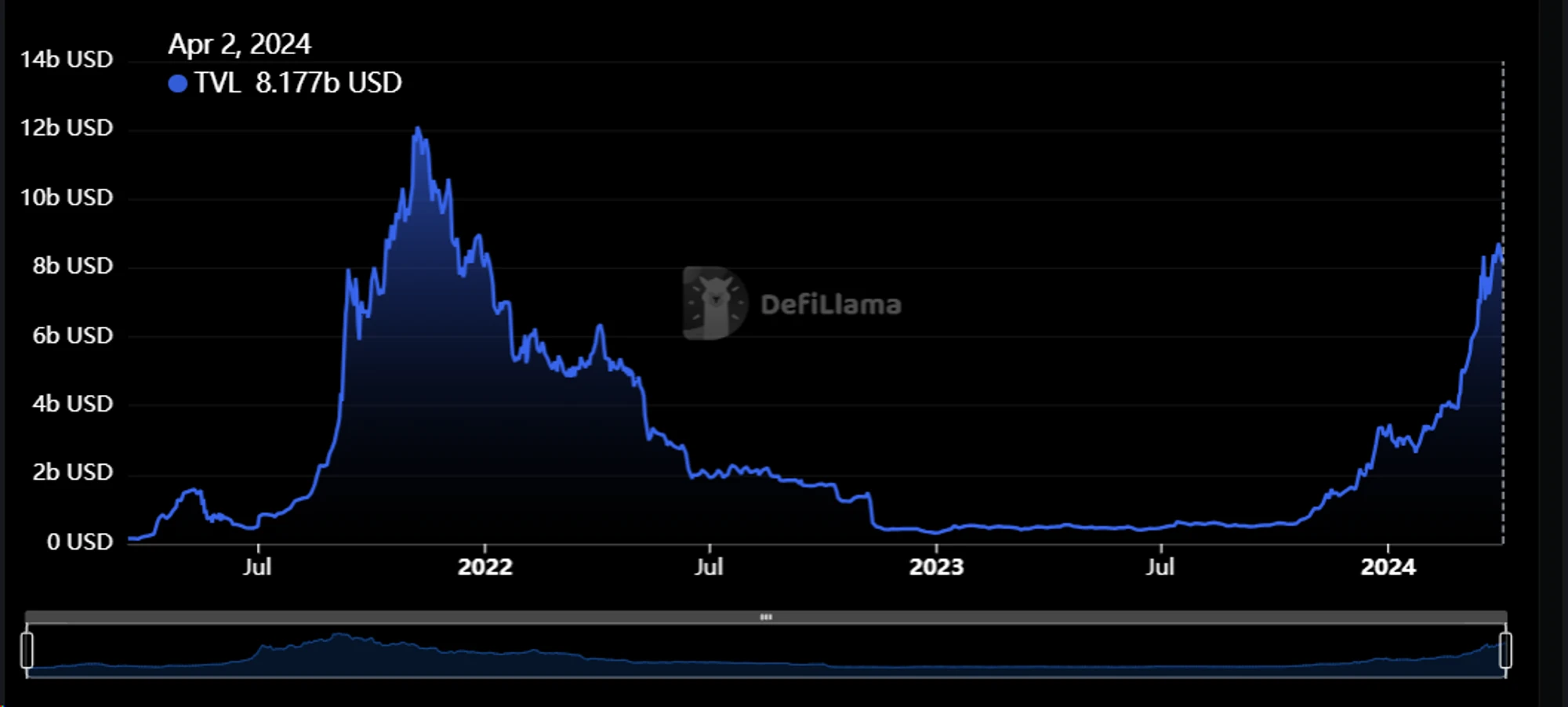
(Solana TVL over time chart, source: DeFiLlama)
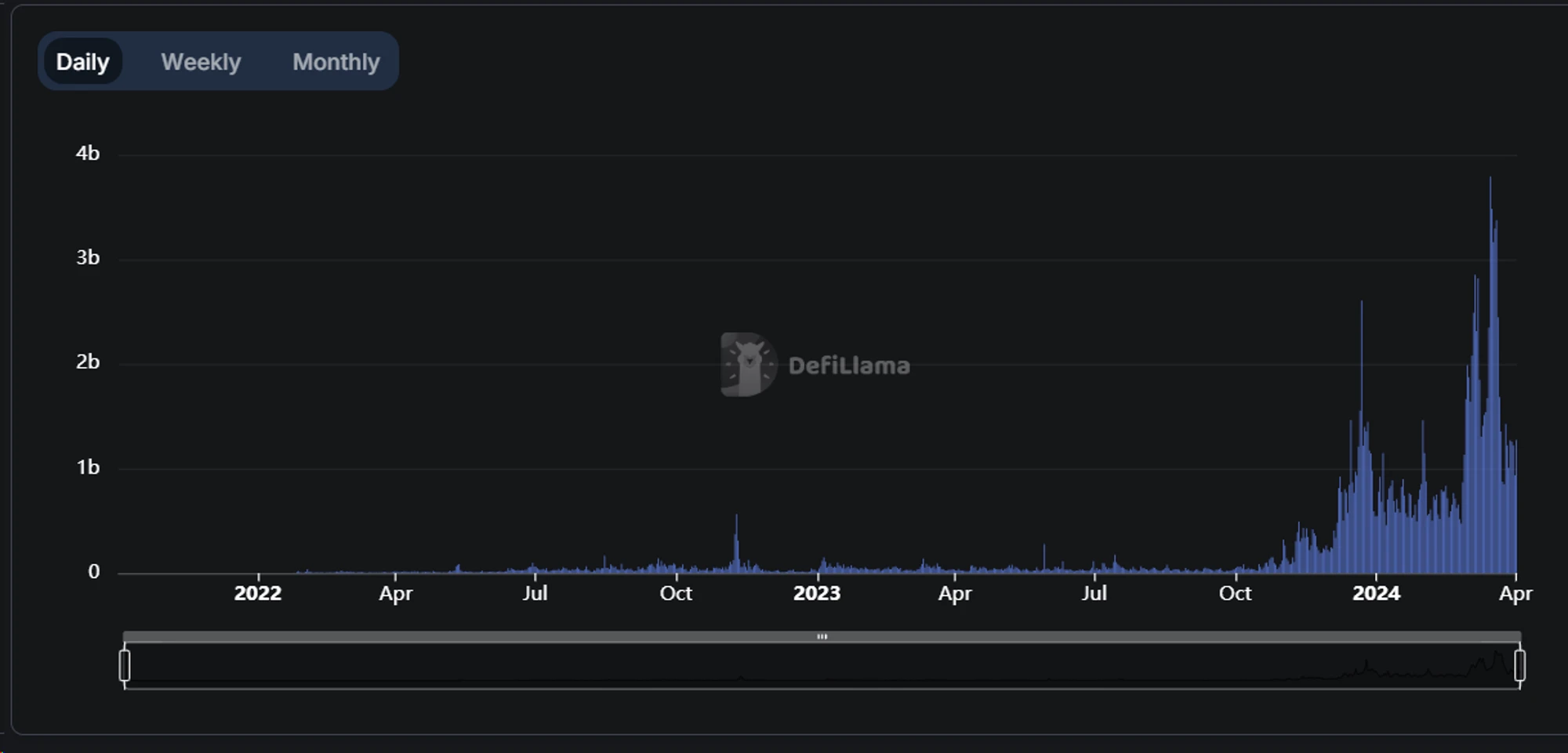
(Solana DEX transaction volume over time chart, source: DeFiLlama)
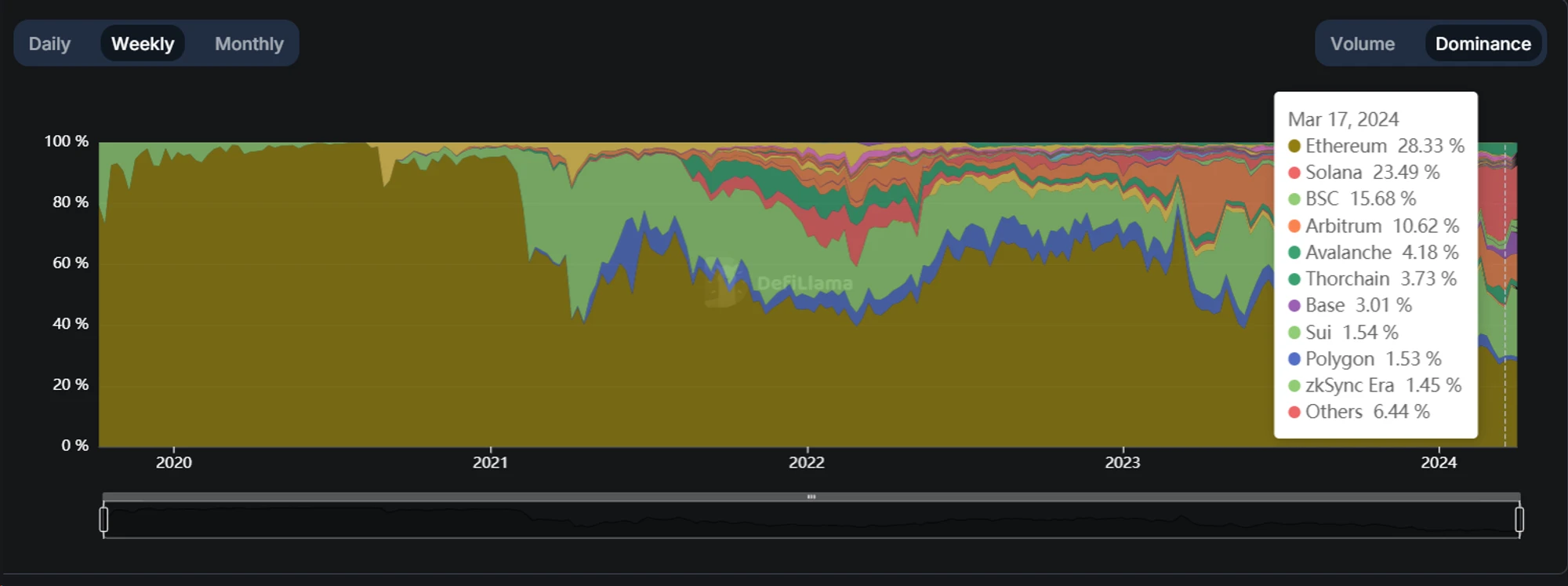
(Chart of changes in DEX Volume Dominance over time for each public chain, source: DeFiLlama)
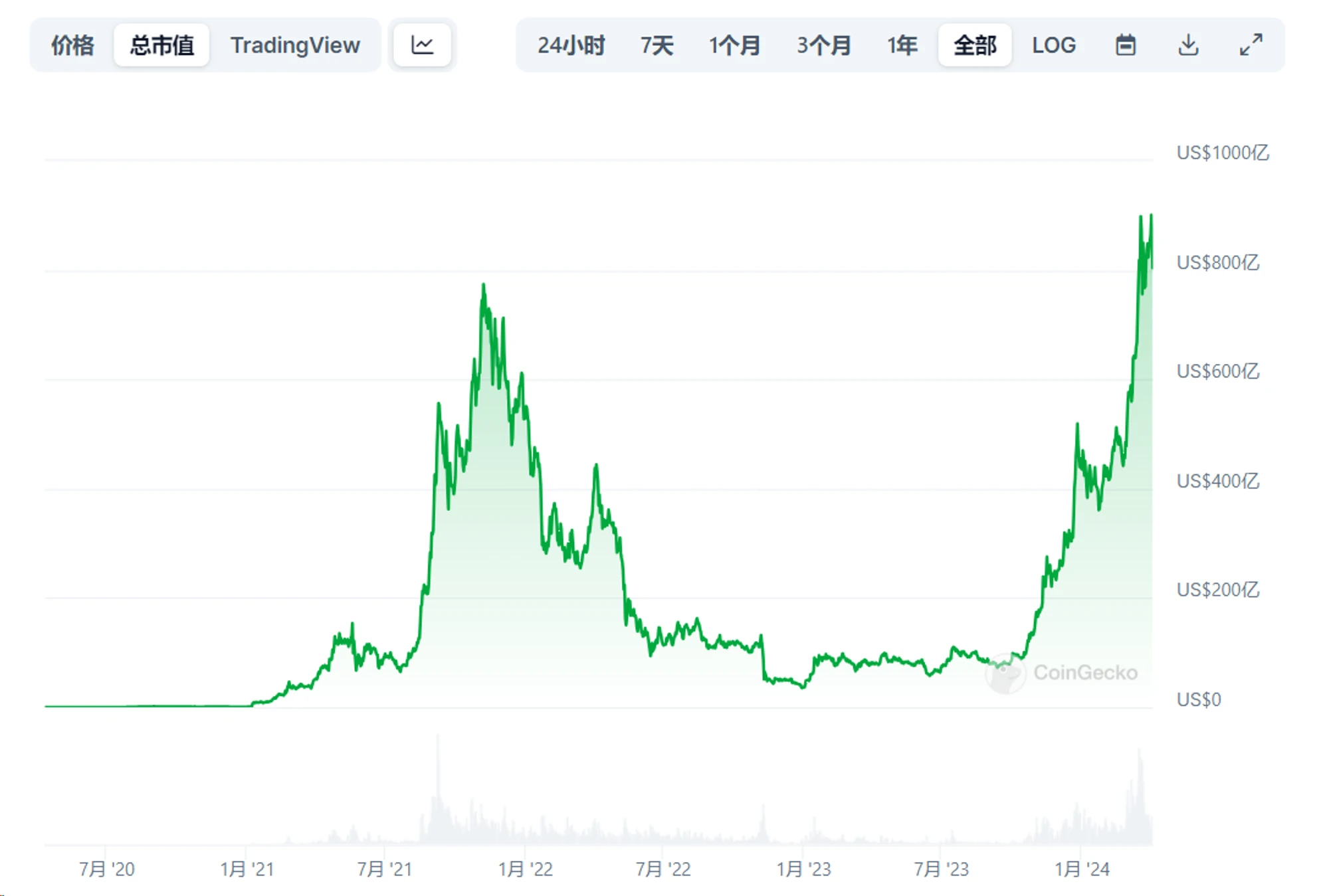
(Solana total market value over time, source: Coingecko)
From other perspectives such as ecology and market sentiment, the reasons why the Solana ecosystem is growing rapidly and still has room for substantial growth include the following:
Solana has emerged from the negative impact of the FTX incident: With the conclusion of SBFs trial, the FTX crash has basically come to an end. From the perspective of the Solana ecosystem, Solana has gradually emerged from the trough of the FTX incident. Whether from the perspective of ecological development, investor views, or market sentiment, the negative impact of the FTX incident on Solana has disappeared. According to The Block, citing people familiar with the matter, the 41 million SOL locked by FTX has attracted multiple buyers, and the market demand for the acquisition of SOL tokens is high. Whether from the perspective of funding or institutional sentiment, it provides a positive indicator for Solanas future growth expectations.
Solana has become the main battlefield of the DePIN project, and multiple ecological projects are about to issue coins: Solana has become the main ecology that carries the DePIN narrative with its low fees and high performance. In addition to DePIN head projects such as Helium, Shadow, and Hivemapper, a number of AI×DePIN projects have also chosen the Solana ecosystem, including io.net , Render, Grass, and Nosana. At the same time, many projects in the Solana ecosystem have not yet issued coins, such as io.net and Magic Eden. Referring to JUP and JTO, the issuance of coins and airdrops by these projects will continue to inject vitality into the Solana ecosystem.
Solana has achieved product-market fit and may become the main interactive ecosystem for retail investors and new users in this round: Solanas high performance and extremely low transaction fees make it extremely suitable for retail transactions, and lower the threshold for transaction fees for new users. Ethereum L1 transaction fees can be as high as tens or even hundreds of dollars during peak periods, and this number is rising with the increase in ETH prices. L2 liquidity is dispersed and the operation difficulty for new users has increased. In addition, the concept of Fair Launch has been deeply loved by retail investors in this cycle. Retail investors generally believe that Ethereum has become the main battlefield of VC disks. On the contrary, Solana ecosystems strong support for MEME coins has driven bottom-up market sentiment. Simple operation, low-priced chips and wealth-creating effects will become the main driving force to attract new retail investors.
In summary, whether it is data performance, ecological prosperity, or market sentiment, the Solana ecosystem has shown strong strength in the past, and has demonstrated the ability to continue to grow and a logical path for growth in a bull market. Whether Solana is an Ethereum killer or not, from a configuration perspective, the Solana ecosystem deserves the same status as the Ethereum ecosystem, and from a growth perspective, it is even more aggressive.
1.2 Jupiter will resonate with Solana
As the liquidity infrastructure of the Solana ecosystem, Jupiter will resonate with Solana.
First, on the Solana network, Jupiter guides about 50%-60% of the trading volume, and more than 80% of the organic trading volume (excluding Trading bots), which means that traders participating in the Solana ecosystem, in addition to using Trading bots, need to interact with Jupiters front-end to complete most of the transactions. Jupiter has become one of the most important protocols in the Solana ecosystem by virtue of its status as a trading infrastructure and its extremely large customer capture. In addition, as a DEX aggregator, Jupiter is actually much more important to the Solana ecosystem than 1inch is to Ethereum, because Solana is naturally more suitable for liquidity aggregators. A transaction divided into multiple times will generate higher gas, which brings high friction to Ethereum, which already has high gas fees, while the cost to users on Solana is still very small. Therefore, in terms of trading volume, Jupiter is basically equivalent to Uniswap, and even surpasses it for a short time. Both are far higher than other trading infrastructures, and can be said to be the Uniswap of the Solana ecosystem.
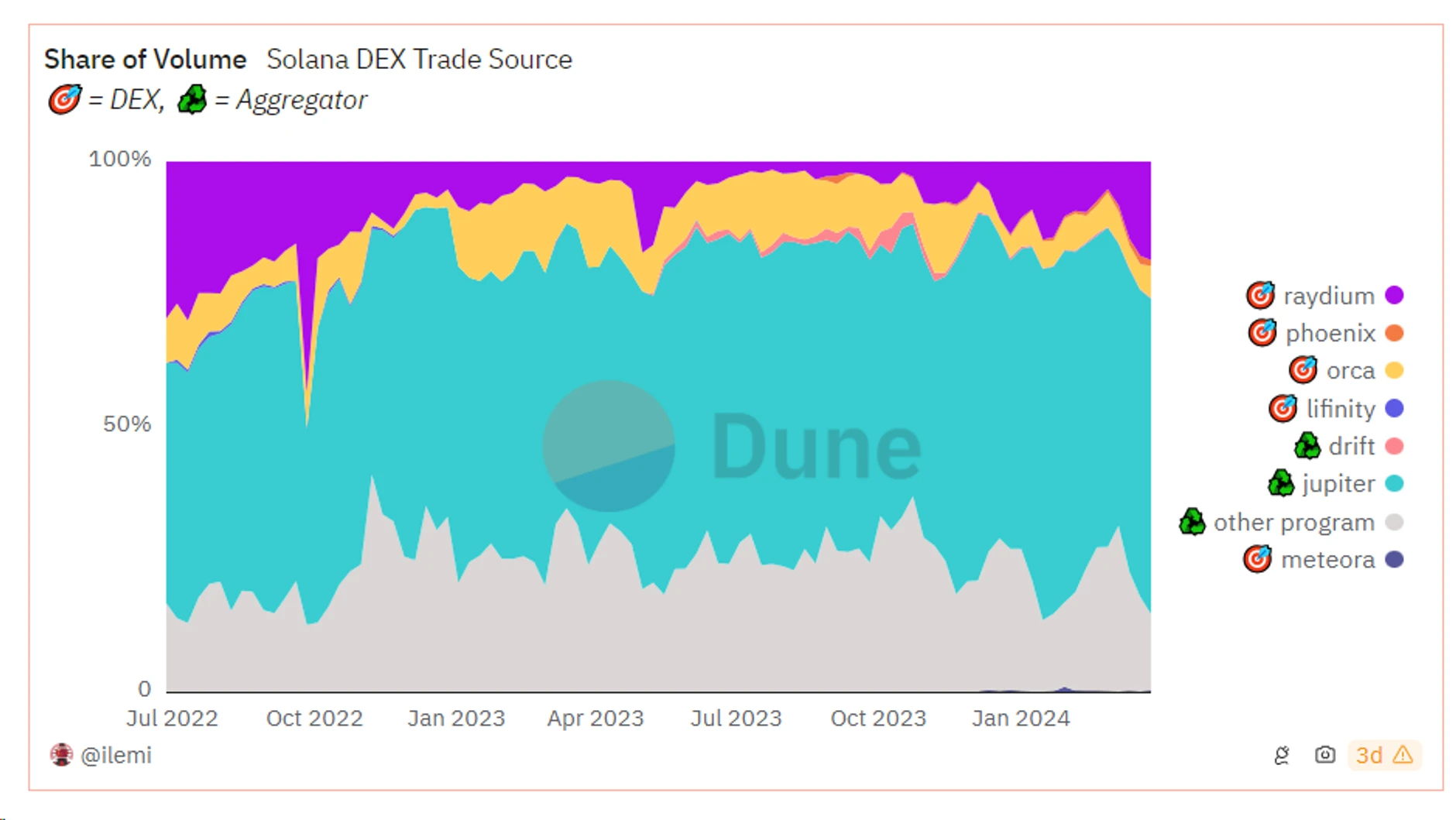
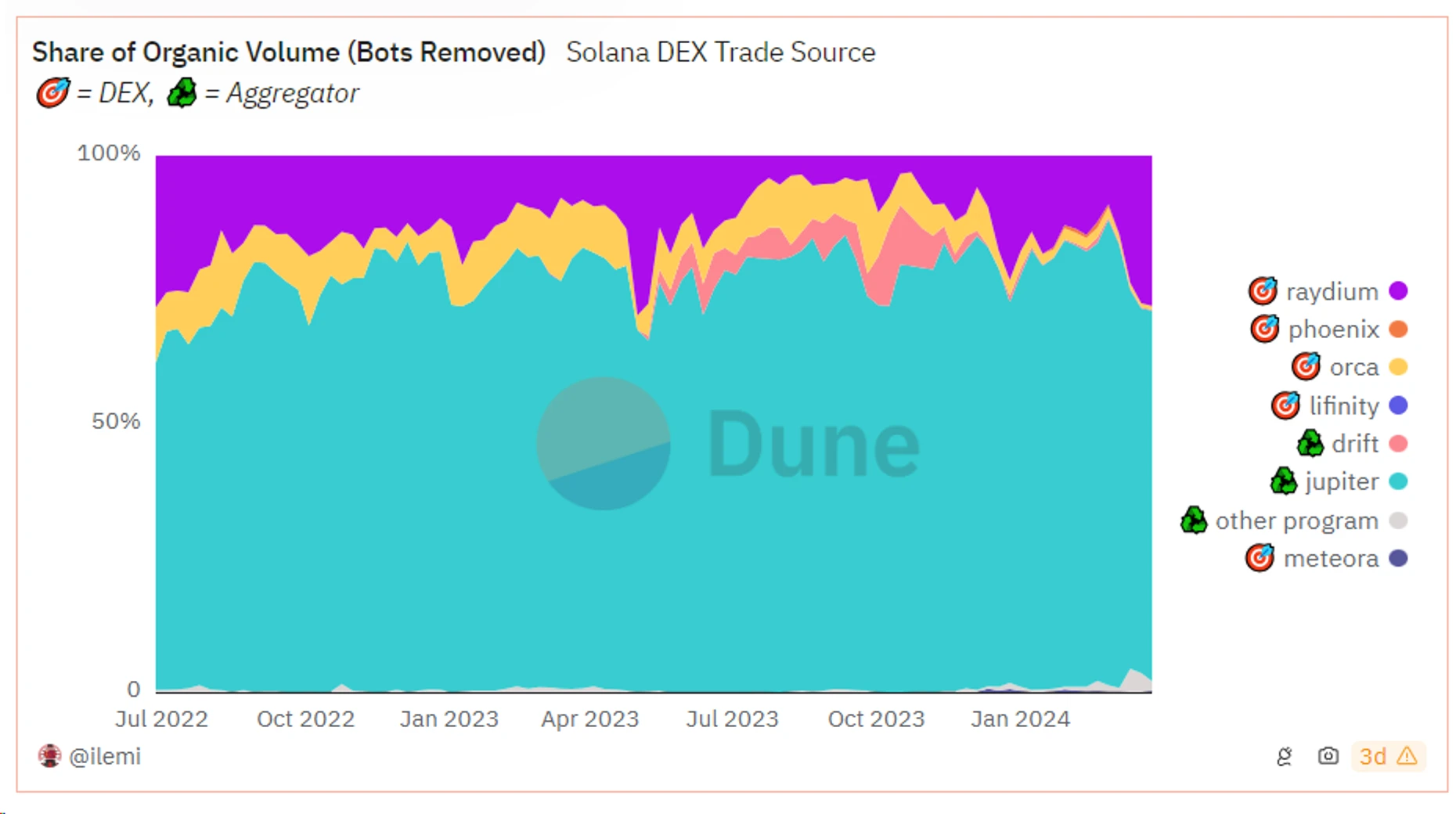
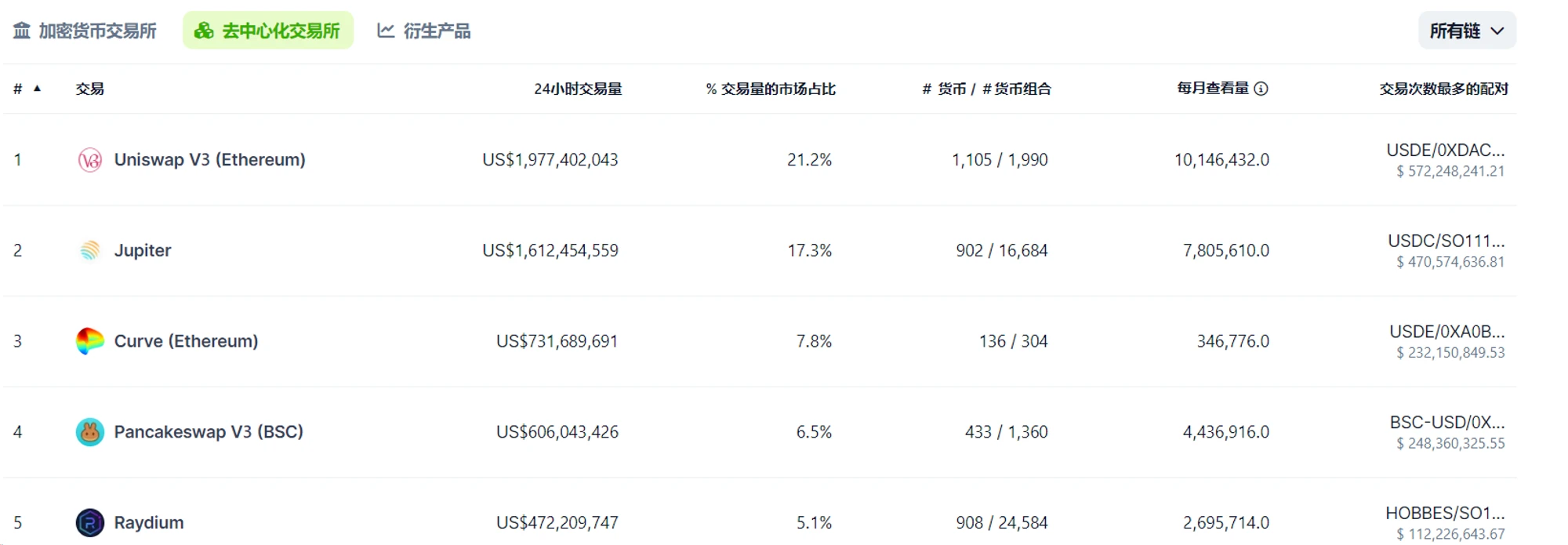
Secondly, Jupiter launched Jupiter Start and Launchpad. With Jupiters great capture of Solana ecosystem users and traffic, it can be foreseen that new projects in the Solana ecosystem in the future will have a high degree of binding with Jupiter. Whether through Jupiter Launchpad or directly airdropping to JUP holders, Jupiter will greatly benefit from the birth and growth of new projects in the Solana ecosystem.
Judging from the token performance at this stage, the price growth of Jupiter and Solana is basically synchronized. In the past month, the increase of JUP has exceeded that of SOL, which also shows that JUP will become a leveraged target of SOL.
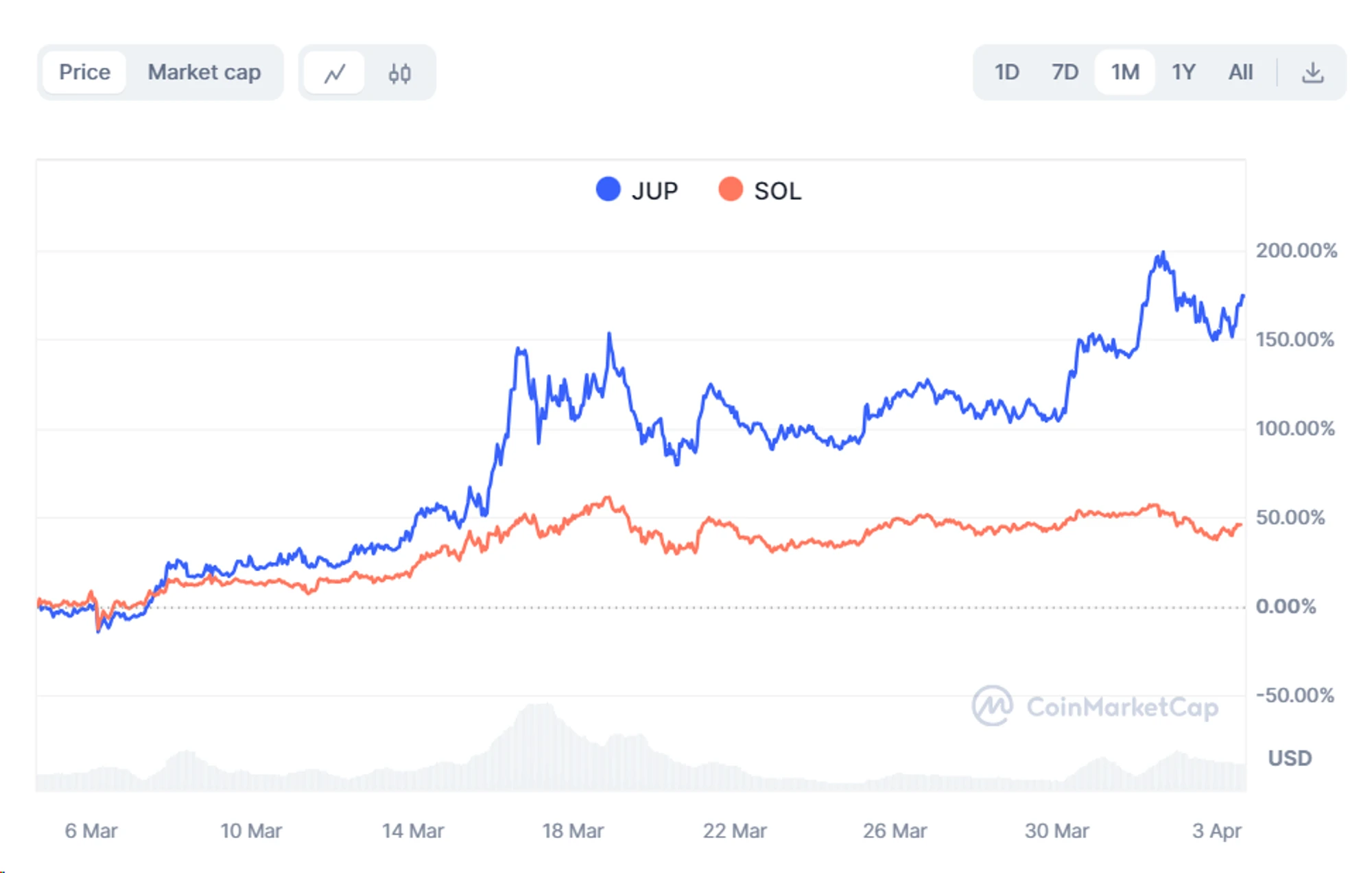
2 Fundamental Analysis: Top DEX Aggregators on Solana
Jupiter was launched in November 2021. Its products can be divided into two parts: trading infrastructure and LFG Launchpad. The trading infrastructure includes liquidity aggregation, limit orders, DCA (fixed investment strategy) and Perps trading. This section will briefly introduce Jupiters products.
2.1 Liquidity Aggregation
Token prices change rapidly at any time. The best price transaction is not always on one DEX, but may involve a combination of transactions on multiple DEXs. As a liquidity aggregator, Jupiter will find the most favorable price route among all major DEXs and AMMs on Solana, which can minimize slippage and transaction fees, making the transaction process more efficient and user-friendly. Aggregators work in two main ways: Multi-hop routing and order splitting. Multi-hop refers to the better exchange of A token to B token through the intermediary token C (ACB), and order splitting is to split a transaction into multiple transactions and complete them on different DEXs.
Jupiter currently uses a routing algorithm called Metis, which aims to provide optimal price routing within Solanas fast block time. Compared to V1 and V2, Metis provides more flexible and complex transaction paths, thereby achieving better price discovery. In addition, the Metis algorithm increases the number of DEXs that can be supported and demonstrates stronger quoting capabilities in large transactions. According to Jupiters official data, Metiss quoting capabilities are 5.22% higher than the V2 engine on average, and the degree of improvement increases rapidly with the increase in transaction amounts.
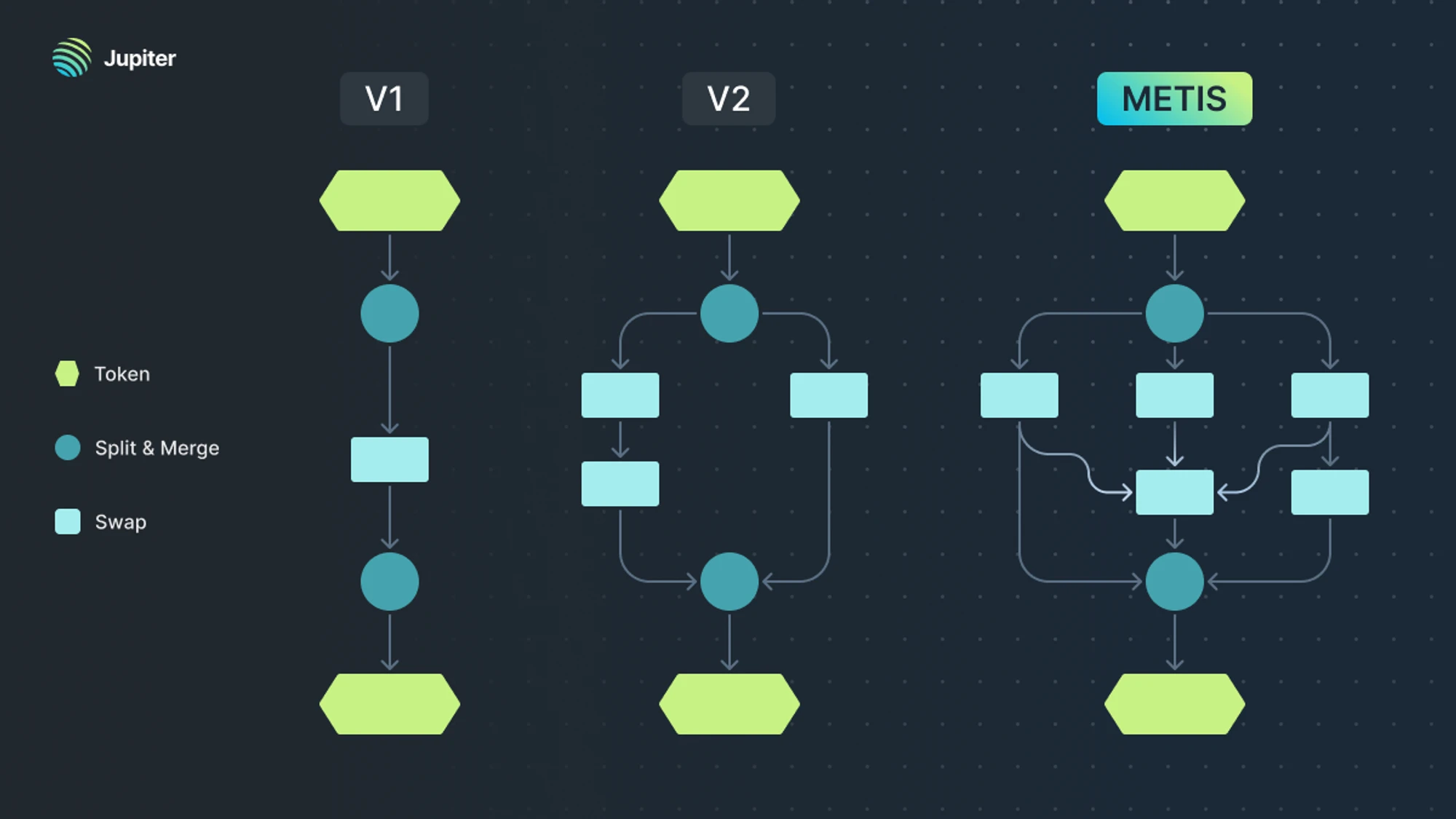
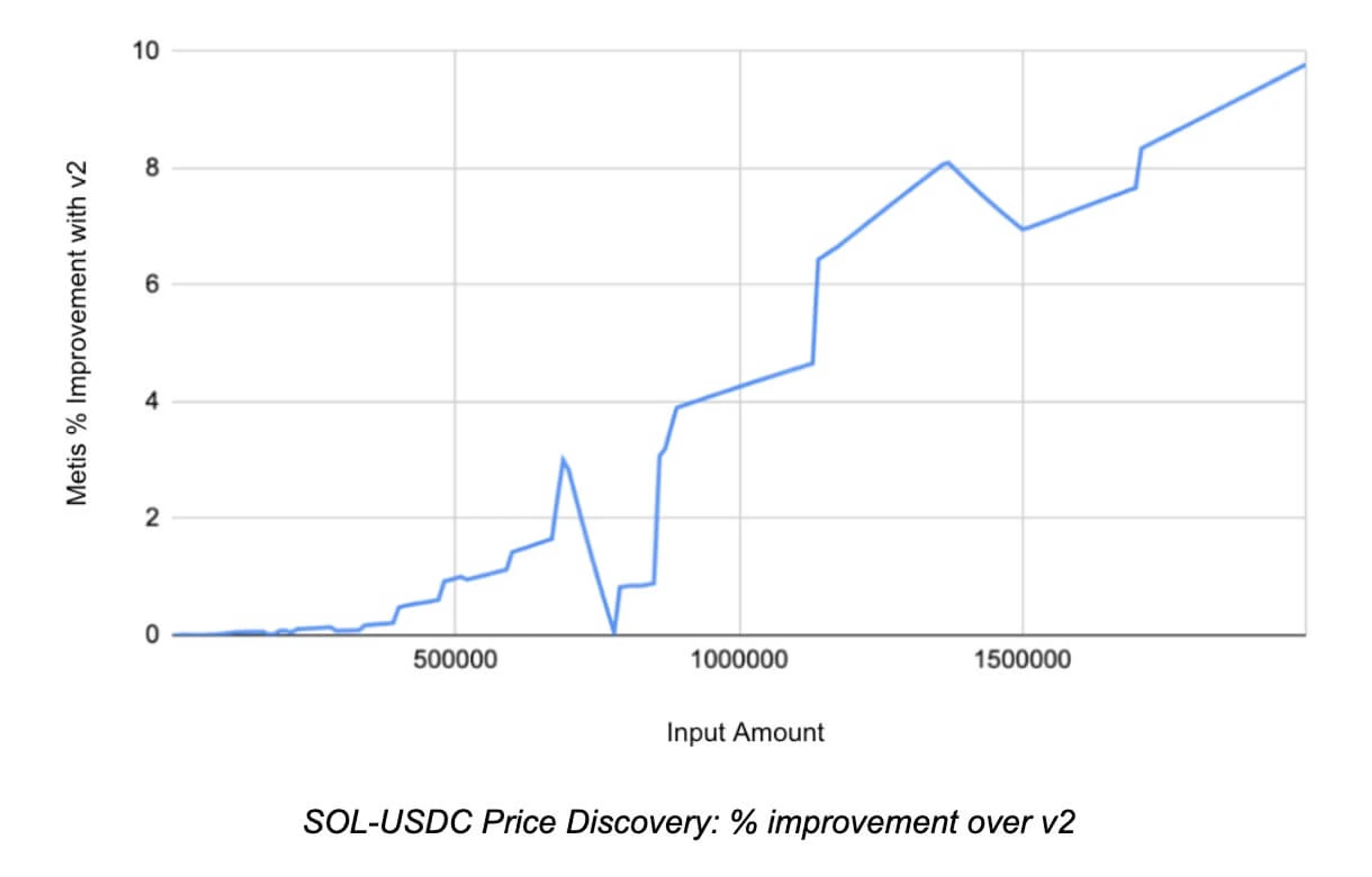
At present, Jupiter aggregator does not charge users. It mainly serves as the front end of user transactions, attracting the attention and traffic of users in the Solana ecosystem, which also makes it very suitable for Launchpad business. However, it should be noted that during the last Solana MEME boom, Jupiters position as a trading front end was impacted by Trading bots. On the one hand, Trading bots have a more user-friendly operation method, and are equipped with functions such as sniping and token information query, which are naturally born for MEME tokens. On the other hand, Jupiters token pair update speed cannot meet the requirements of MEME opening rush. Token pairs must be displayed on Jupiter only after meeting certain liquidity requirements.
2.2 Limit Order
Jupiter provides users with a limit order function, allowing users to have a CEX-like trading experience, avoiding slippage caused by rapid changes in on-chain prices and MEV problems. Similar to other on-chain limit order platforms, Jupiter limit orders are not order book systems, but are monitored by Keeper using the Jupiter Price API to execute transactions when the price reaches the specified standard. Benefiting from Jupiters liquidity aggregation function, limit orders can also use multiple liquidity pairs on Solana to complete transactions.
Currently, Jupiter supports transactions between any token pairs, which actually provides a more convenient trading experience than CEX. At the same time, Jupiter cooperates with Birdeye and TradingView. Birdeye provides on-chain price data, and TradingView is integrated in the front end to provide users with more convenient chart data display. Jupiter currently charges a platform fee of 0.1%.
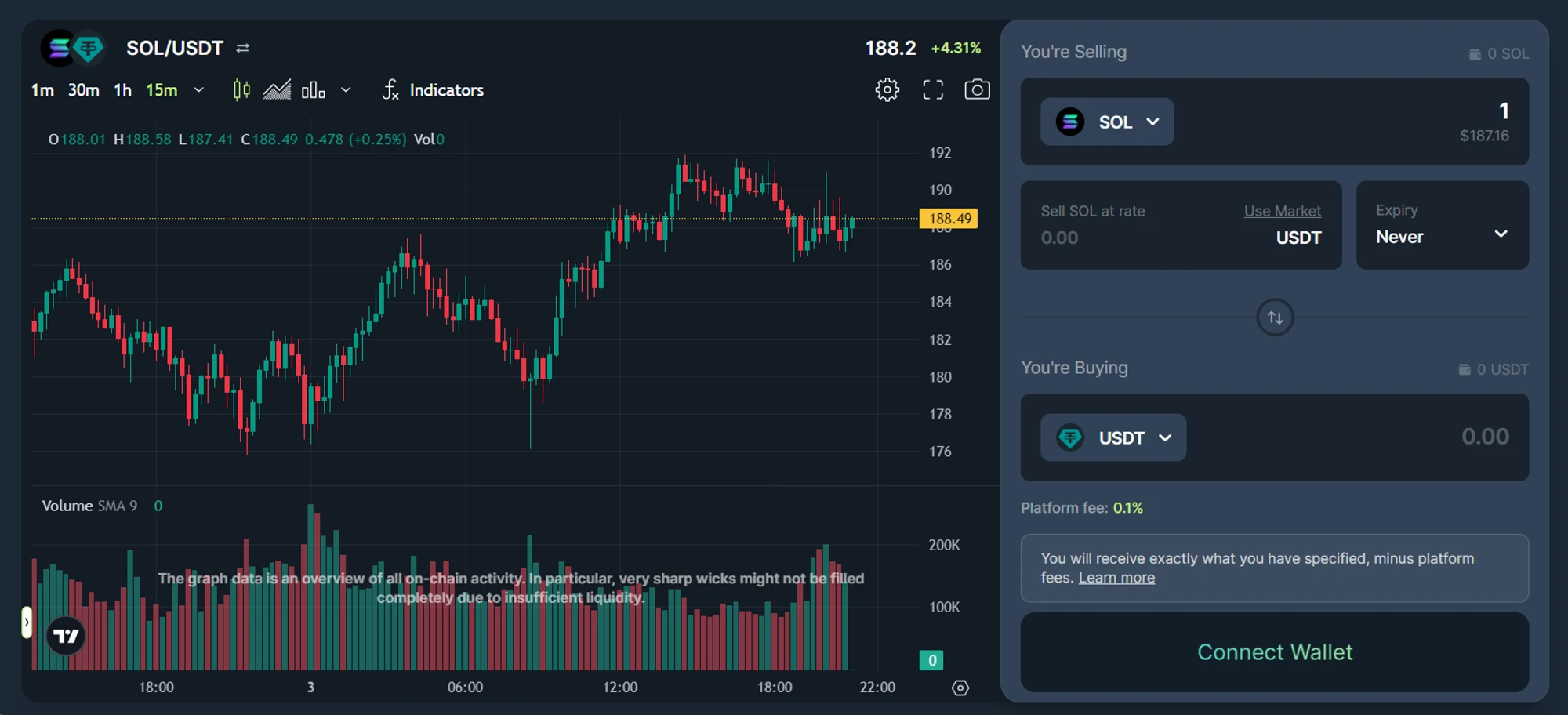
2.3 DCA
Jupiter DCA (Dollar Cost Averaging) is a fixed investment solution that enables users to automatically buy or sell any Solana ecosystem token regularly over a certain period of time. Jupiter DCA charges a platform fee of 0.1%, which will be charged on each transaction execution. The DCA method is a very important basic strategy for both buying and selling. Accumulating chips by fixed investment can avoid sharp price fluctuations and obtain a relatively stable and average cost price over a period of time. DCA is also suitable for selling strategies when making profits in a bull market. In addition, for large transactions or tokens with poor liquidity, you can choose to continue to accumulate chips over a period of time to reduce the price impact.
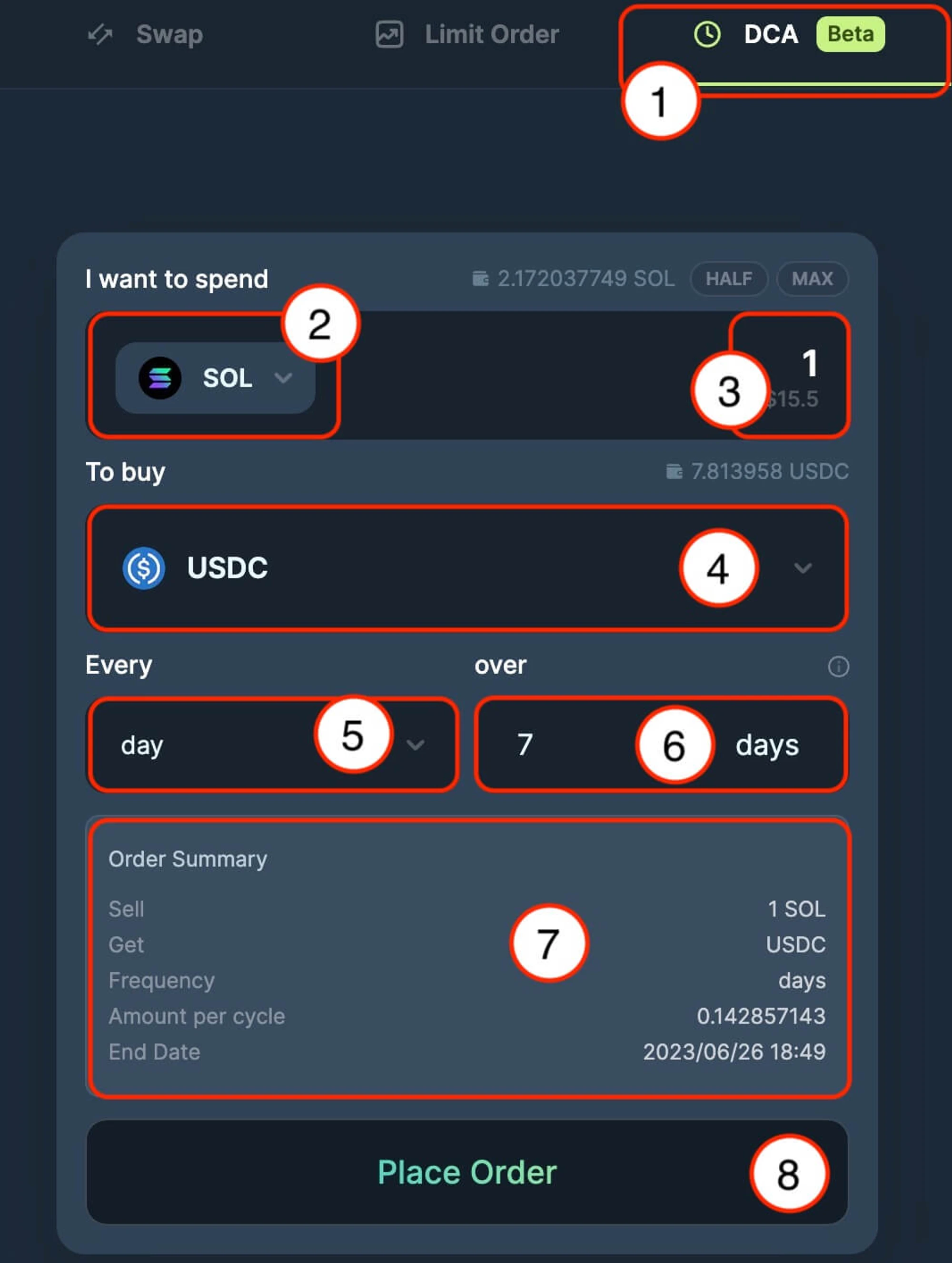
2.4 Perps Trading
Perps trading is based on LP providing liquidity and Pyth oracle providing price data, and is currently in the Beta testing stage. The operating mechanism of Perps trading is similar to the GLP pool model of GMX. LP provides liquidity for the JLP pool. Contract traders pledge various Solana assets and choose a leverage multiple of 1.1x-10 0x to borrow relevant liquidity from the JLP pool (for example, a contract that is long SOL needs to borrow a corresponding amount of SOL according to the leverage multiple, and a contract that is short SOL needs to borrow stablecoins). After closing the position, the trader obtains the profit/closes the loss and returns the remaining tokens to the JLP pool. For a long SOL, if the trader makes a profit, the amount of SOL owned by the JLP pool will decrease, and the traders profit part comes from the JLP pool.
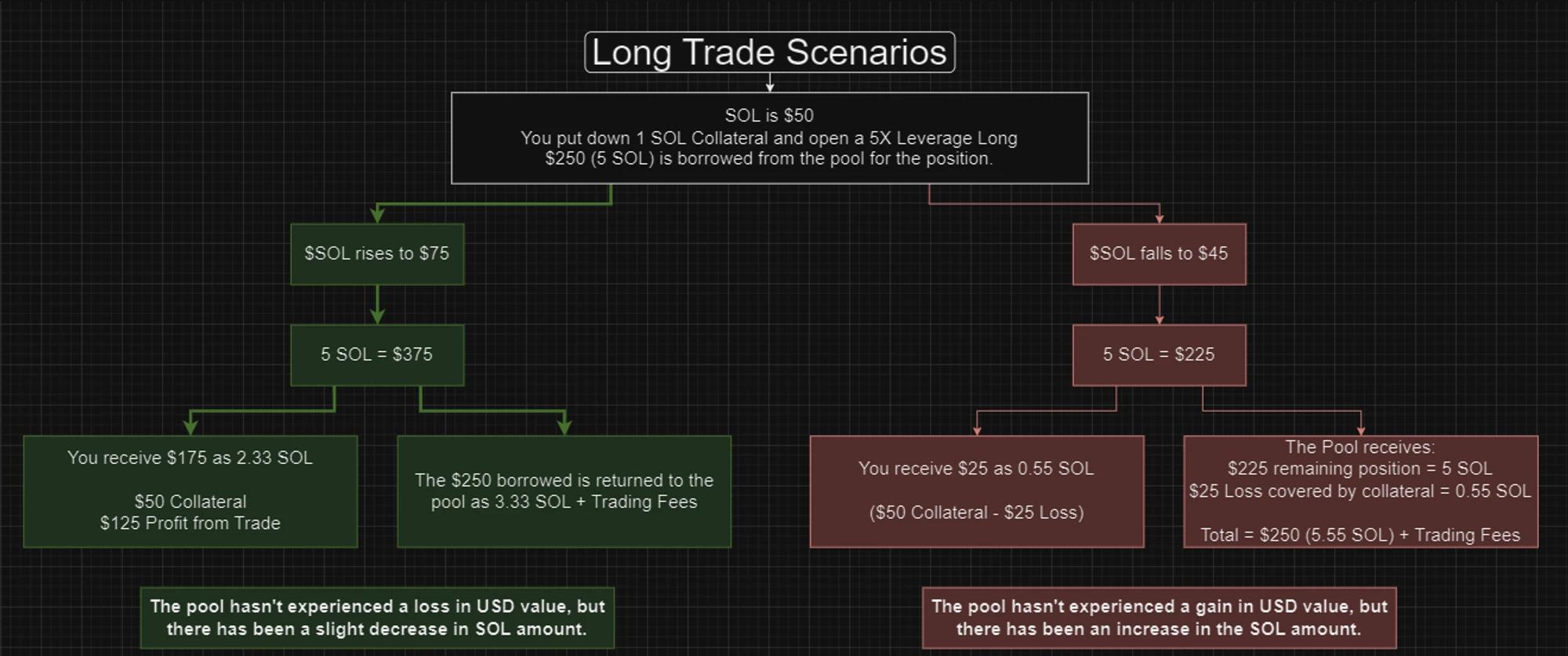
Currently, the JLP pool supports five assets: SOL, ETH, WBTC, USDC, and USDT. The JLP pool will receive 70% of the exchanges revenue, which includes transaction fees for opening and closing positions, as well as interest fees for borrowing (the relevant charging standards are shown in the table below). The current TVL of the JLP pool is $331,384,506.56, and the corresponding asset proportions are shown in the figure below.
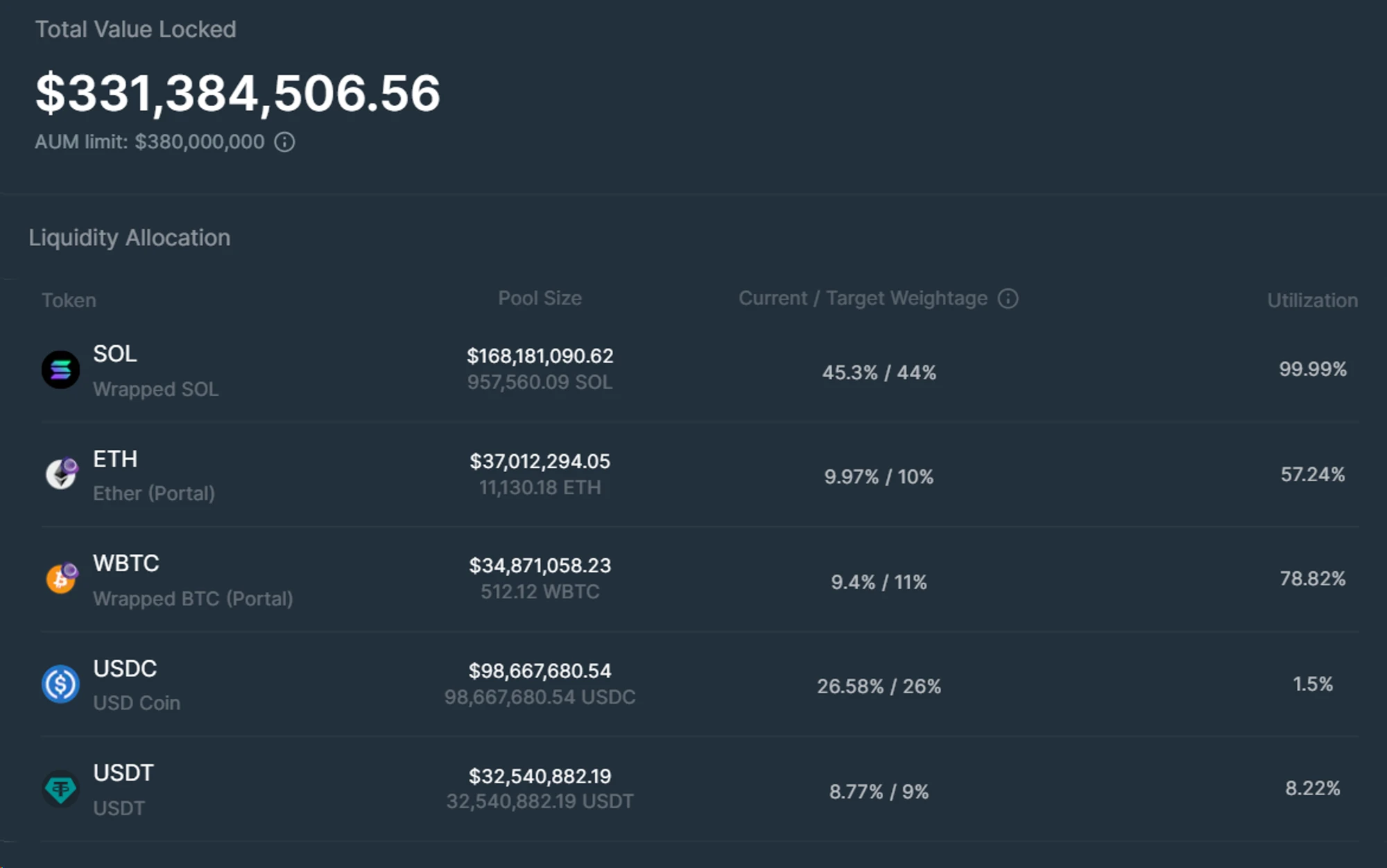

2.5 LFG Launchpad
Jupiter launched the Beta version of Launchpad in January 2024 and has completed the token issuance of JUP, WEN, and ZEUS. The participants of Launchpad are mainly divided into three categories: project parties, JUP community, and users who purchase tokens.
For project owners, Jupiter is the largest traffic entrance on Solana. Choosing Jupiter as the launchpad will greatly capture Solana ecosystem users. At the same time, projects participating in the Launchpad need to provide a certain amount of tokens (generally 1% of the tokens) to incentivize the JUP community and team.
The JUP community is composed of voters who own and stake JUP. They vote to decide the next project to be launched on Jupiter and receive corresponding rewards. In terms of voting rules, many users lock a certain amount of JUP to obtain a corresponding number of voting rights. There is no minimum token requirement for voting, but each wallet can only vote for 1 project. It takes 30 days for the token to be unlocked. During the unlocking countdown, users can still vote, but their voting rights will be reduced accordingly. After voting, the two projects that will be launched on Jupiter are Zeus Network and Sharky. For JUP holders, the benefits of choosing to stake and vote include:
Launchpad project airdrops: For example, Zeus Network announced airdrops to 181,889 addresses that participated in the Jupiter LFG Launchpad voting. In order to attract JUP votes, it may be inevitable for the project to airdrop to voters;
Jupiter Governance Rewards: 100 million JUP and 75% of Launchpad fees will be used for governance incentives. Rewards will be distributed quarterly. This quarters rewards will be 50 million JUP and this quarters Launchpad fees. The remaining 50 million JUP will be rewarded in the next quarter. The Launchpad fee is 0.75% of the total token supply paid by the project to the JUP DAO.
For token buyers, JUP Launchpad uses the DLMM (Dynamic Liquidity Market Maker) model for token sales. The DLMM model divides a price range into multiple discrete price ranges. The team mainly provides token liquidity, and users provide USDC liquidity, completing the token sale in this process. In addition, in order to reduce the impact of complex mechanisms on users, Jupiter still provides DCA and limit order functions, allowing users to complete token purchases based on appropriate strategies during the token sale period.

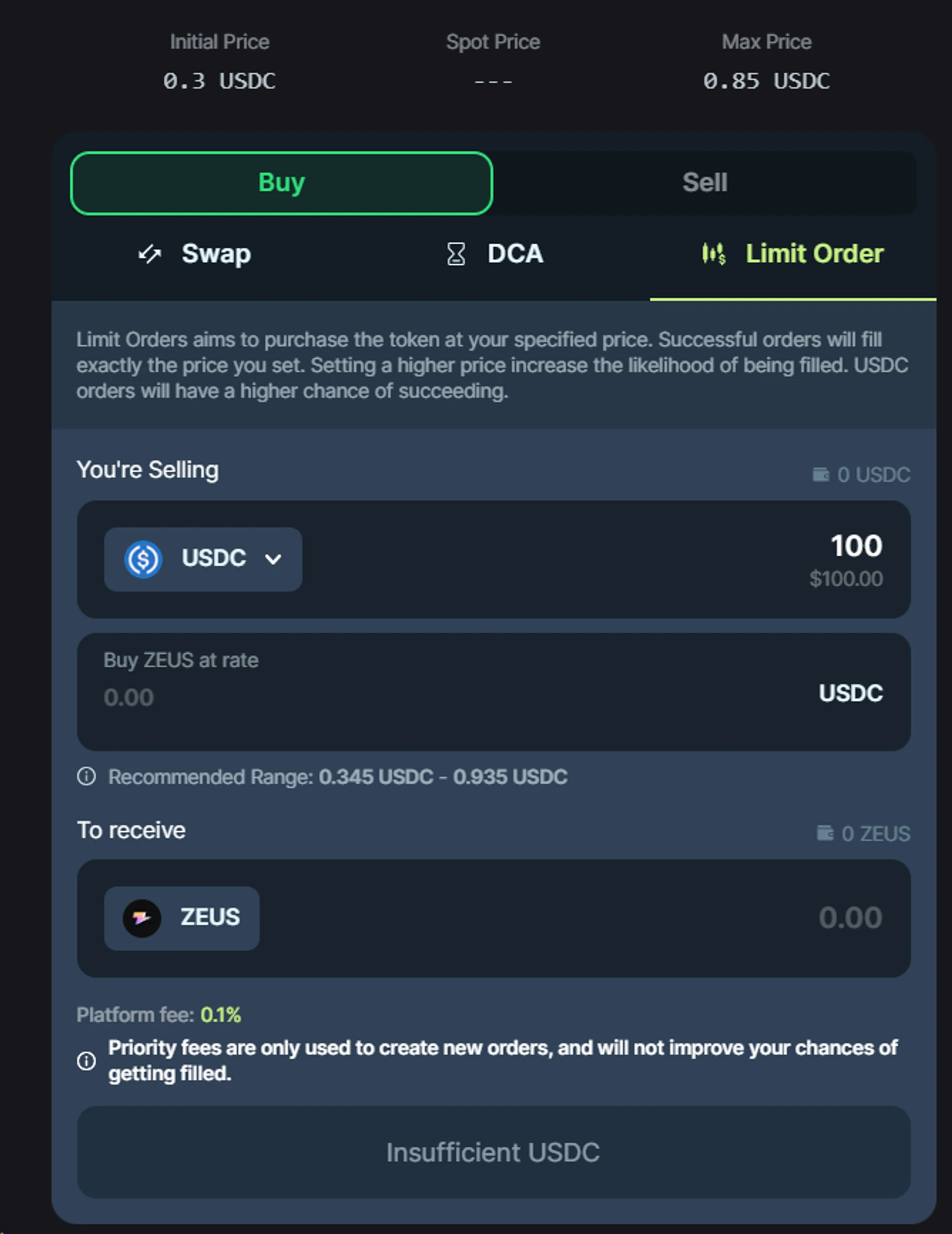
Currently, the first unofficial project of Jupiter Launchpad, Zeus Network, is being sold. The launch price of ZEUS on Launchpad ranges from $0.3 to $0.85, with the highest price reaching $1.11 and the current price being $0.83 (data from April 11). At this price, the total airdrop value shared by JUP voters is $8,300,000 (1% ZEUS). In addition, among the issued JUP and WEN, the vast majority of participants have received more than 3 times the benefits:


2.6 Summary
Based on the above analysis, we believe that Jupiters product advantages are as follows:
Jupiter provides a full set of basic trading tools to create an excellent user trading experience: **From the most basic spot and Perps transactions to DCA and limit orders, it provides users with almost all the necessary basic functions. At the same time, benefiting from the liquidity aggregation function, DCA and limit orders also connect to a wider range of liquidity.
The business development direction from trading infrastructure to Launchpad is reasonable: **The trading infrastructure has captured a large number of users, making Jupiter the traffic center of Solana, which naturally meets the needs of Launchpad, and the various trading functions also lower the threshold for users to participate in token issuance; The function of Launchpad makes Jupiter more deeply bound to the Solana ecosystem, strengthens Jupiters infrastructure and leading position, and at the same time increases the token empowerment of JUP.
3 Token Economics and Funding Analysis
3.1 Token Economics Analysis
The total supply of Jupiter is 10 B, and the token distribution is as follows: the Jupiter team will manage 50% of the tokens, and the remaining 50% will be distributed to the community.
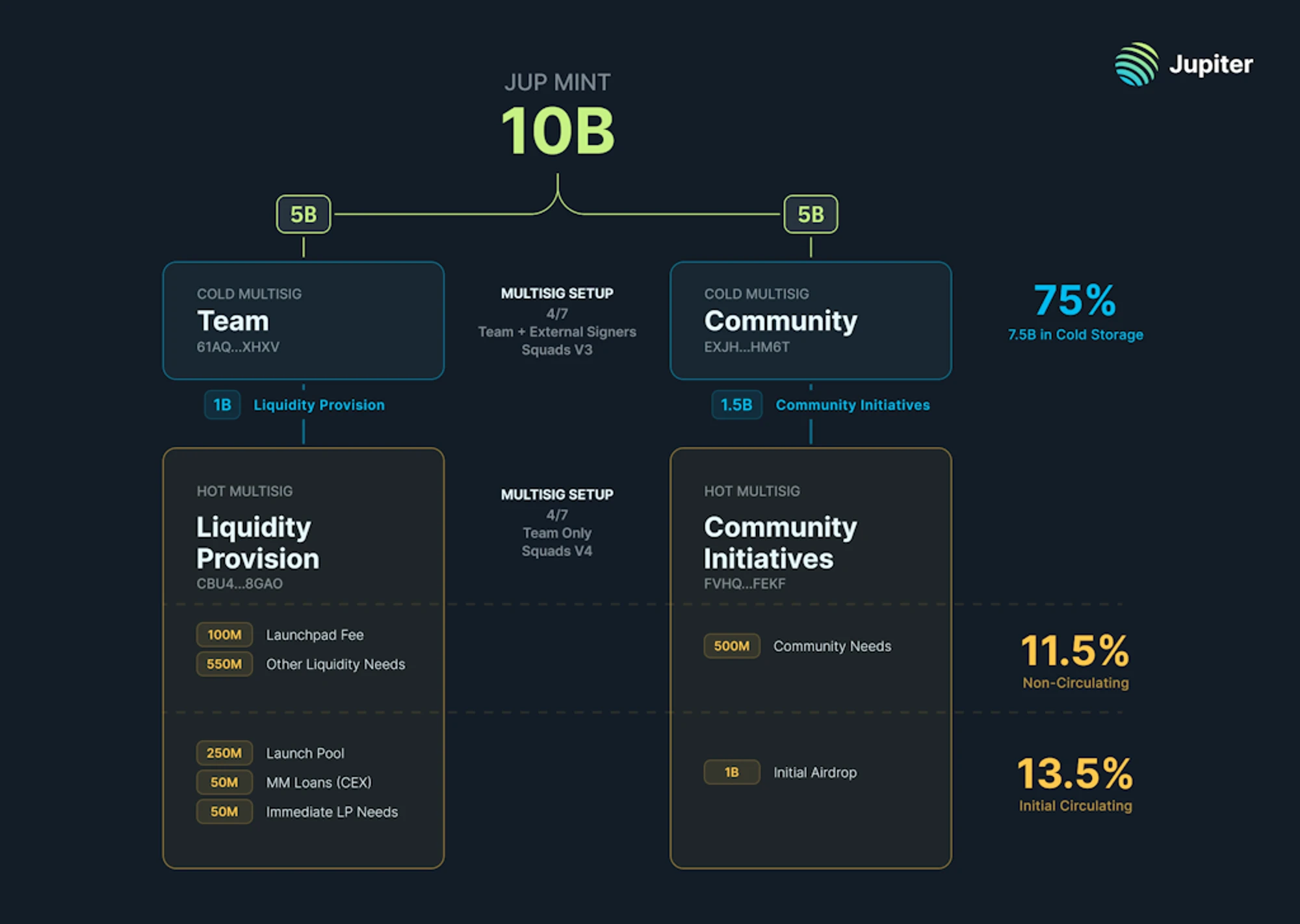
Of the 50% of tokens belonging to the team, 20% will be distributed to team members, but the distribution will not begin until two years later. 20% will enter the strategic reserve and be kept in the 4/7 Team Cold Multisig wallet. These tokens will be locked for at least one year, and the community must be notified at least six months in advance of any liquidity event. The remaining 10% of JUP tokens will be used as liquidity supply and kept in the Team Hot Multisig wallet.
Of the 50% of tokens that will vest in the community, 40% will be distributed through four separate airdrops, which will take place on January 31st of each year, and the remaining 10% of tokens will be given to community contributors through grants.
In the Genesis launch, a total of 1.35 B (13.5%) tokens entered circulation, including a 10% separate airdrop (1 B), 250 million tokens allocated to Launchpad, 50 million as loans to market makers, and 50 million for liquidity provision.
Therefore, according to the token supply plan, there will be no large-scale unlocking of JUP before 2025, and 50% of the tokens belonging to the team will not be unlocked in the next year, and the unlocking will be notified to the community six months in advance. The next large-scale unlocking will come from the 1 B airdrop on January 30, 2025.
In terms of token empowerment, the main use is currently to stake and vote to obtain governance incentives and Launchpad project airdrops. As of April 4, 2024, a total of 269, 290, 321 JUPs have been staked, accounting for about 20% of the current circulation. However, it is worth noting that Jupiters founder Meow said in a Reddit AMA that the JUP token is not designed for practicality, and that the price growth of JUP will come from value rather than actual utility.
3.2 Funding Analysis
The market value of JUP is $2,101,677,968 and that of FDV is $15,567,984,945 (data as of April 11). Since there will be no large-scale unlocking in the next year, the market value has a stronger reference significance than FDV.
JUP transactions are mainly concentrated on Binance, followed by OKX, Bybit and Gate. According to trading data on Binance, JUP has maintained a price of around 0.5 for a long time, and completed a large number of turnovers in the price range of 0.5-0.7, which is the intensive cost range of JUP and has become a strong support. After 2 months of precipitation, the price of JUP began to break through the bottom cost range and has now entered a new price range.
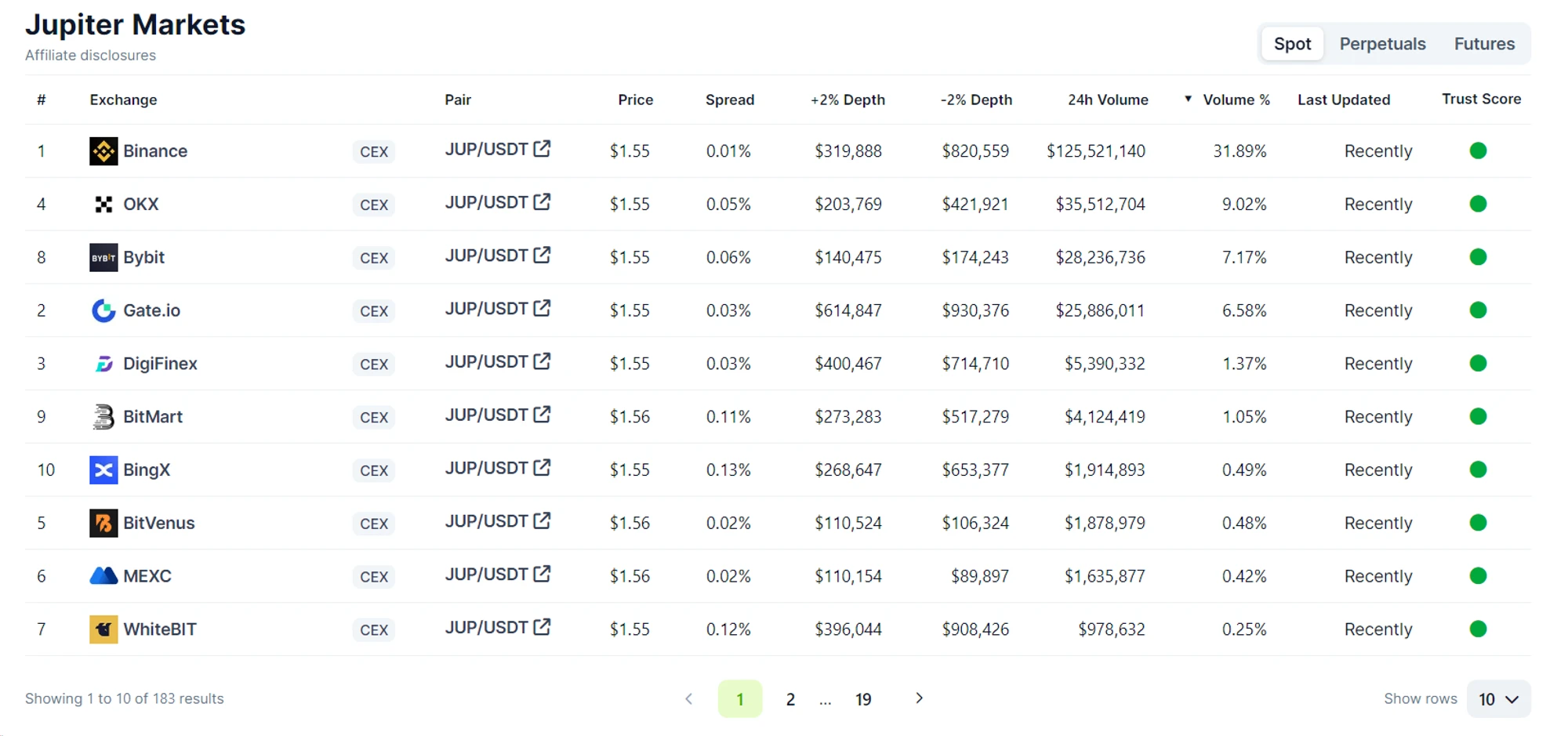
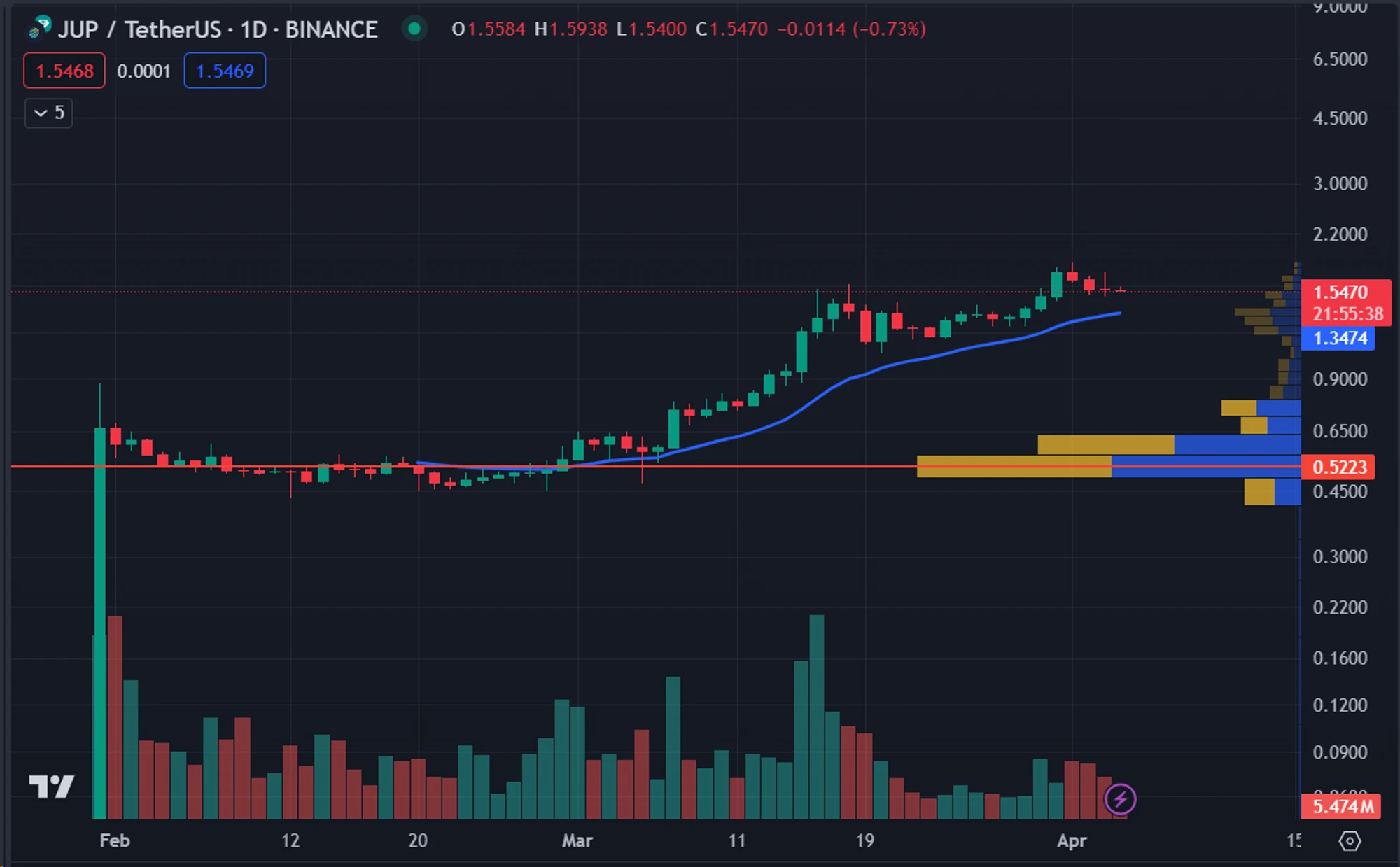
4 Competitive Analysis: Who is Solana’s best leverage target?
As a trading aggregator, Jupiter is in a unique position in the Solana ecosystem. With its unique functions and large-scale capture of trading volume, no trading protocol in the Solana ecosystem can compete directly with Jupiter. Therefore, what we need to consider is whether JUP is a good choice if we need to select leveraged assets in the Solana ecosystem?
There are many options for leveraging the Solana ecosystem: infrastructure (such as JUP), leading MEME (such as WIF), and other ecological projects (such as AI, DePIN projects), but the benefits gained by different categories are different. MEME has stronger uncertainty, while other ecological projects are more related to their own narratives (for example, RNDR will benefit from the growth of AI narratives rather than the growth of the Solana ecosystem). Therefore, the projects that resonate most with Solana are the infrastructure protocols of the Solana ecosystem, such as trading infrastructure (Raydium/Orca/Jupiter), liquidity staking protocols (Jito), and oracles (Pyth). Compared with these projects, Jupiters advantages mainly lie in:
In terms of basic business, Jupiter has captured more users and traffic of the Solana ecosystem. Among all businesses, the most basic business required by users is trading, especially since the Solana ecosystem has recently focused on Memecoin as its core demand, which further strengthens the importance of trading. Based on Jupiters monopoly position in the Solana transaction front end, users who enter the Solana ecosystem will naturally become Jupiter users. Jupiter will become the first stop for users in the Solana ecosystem, and has the strongest and most direct binding relationship with the Solana ecosystem, and is also the most representative of the Solana ecosystem;
In terms of new ecosystem airdrops, Jupiters launchpad function enables JUP holders to receive airdrop rewards from new projects, while Raydium/Orca and Jito have not yet shown strong competitiveness in this regard. Another project that can capture potential airdrops is Pyth, and multiple projects have already provided airdrop rewards to Pyths stakers (such as Wormhole). We need to continue to pay attention to the advancement speed of Jupiters launchpad and the wealth-creating effect of issuing tokens. For example, if Jupiter uses its own traffic advantages to attract a large number of high-quality projects to launch, JUP holders will get higher returns and capture more value from new projects in the Solana ecosystem.
5 Conclusion
Jupiter is regarded by many as the Uniswap and Golden Shovel of Solana ecosystem due to its trading entry and Launchpad functions, and JUP is also regarded as BNB. Based on the above analysis, we believe that Jupiters bullish advantages are:
A complete product matrix related to trading has been built, which greatly improves the user trading experience. Jupiters trading volume has increased rapidly and has become the second largest trading infrastructure after Uniswap.
Backed by the strong traffic and user base captured by Jupiter, Jupiter established Launchpad to capture more value of new projects in the Solana ecosystem and provide JUP token stakers with numerous new project airdrop rewards. Several projects launched so far have achieved good price performance.
In terms of funds, JUP tokens will not face large-scale unlocking and selling pressure in the next three quarters, and the chip structure is relatively stable. From the perspective of price performance, JUP has moved out of the bottom cost range and entered a new growth space.
Jupiter can be seen as a leveraged target of Solana due to its close connection with the Solana ecosystem. Solana will be a public chain and ecosystem as important as Ethereum in this cycle. As Solanas market value has reached a new high, a better way to ambush Solana may be to choose JUP as an amplifier.
Risks associated with Jupiter may include:
Solana ecosystem growth has not met expectations;
The improvement of a large number of trading bots or other trading front ends will challenge Jupiters position as the first trading entrance;
Jupiter’s tokens lack utility, and token price growth may be hampered;
The results of Jupiter Launchpad (including the number, quality and wealth-creating effect of projects) did not meet expectations.
about Us
Metrics Ventures is a data and research driven crypto asset secondary market liquidity fund led by an experienced team of crypto professionals. The team has expertise in primary market incubation and secondary market trading, and plays an active role in industry development through in-depth on-chain/off-chain data analysis. MVC works with senior influencers in the crypto community to provide long-term empowerment support for projects, such as media and KOL resources, ecological collaboration resources, project strategies, economic model consulting capabilities, etc.
Everyone is welcome to DM to share and discuss insights and ideas about the market and investment of crypto assets.
Our research content will be published simultaneously on Twitter and Notion, welcome to follow:
Twitter: https://twitter.com/MetricsVentures
Notion: https://www.notion.so/metricsventures/Metrics-Ventures-475803b4407946b1ae6e0eeaa8708fa2?pvs=4
Hiring! We are looking for traders with good salary and flexible working location.
If you: have bought sol below 40/ ordi below 25/ inj below 14/ rndr below 3.2/ tia below 10 and meet any two of the above, please contact us at admin@metrics.ventures, ops@metrics.ventures










